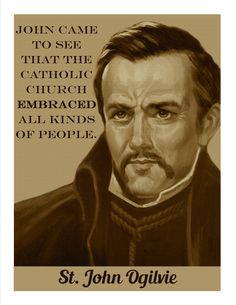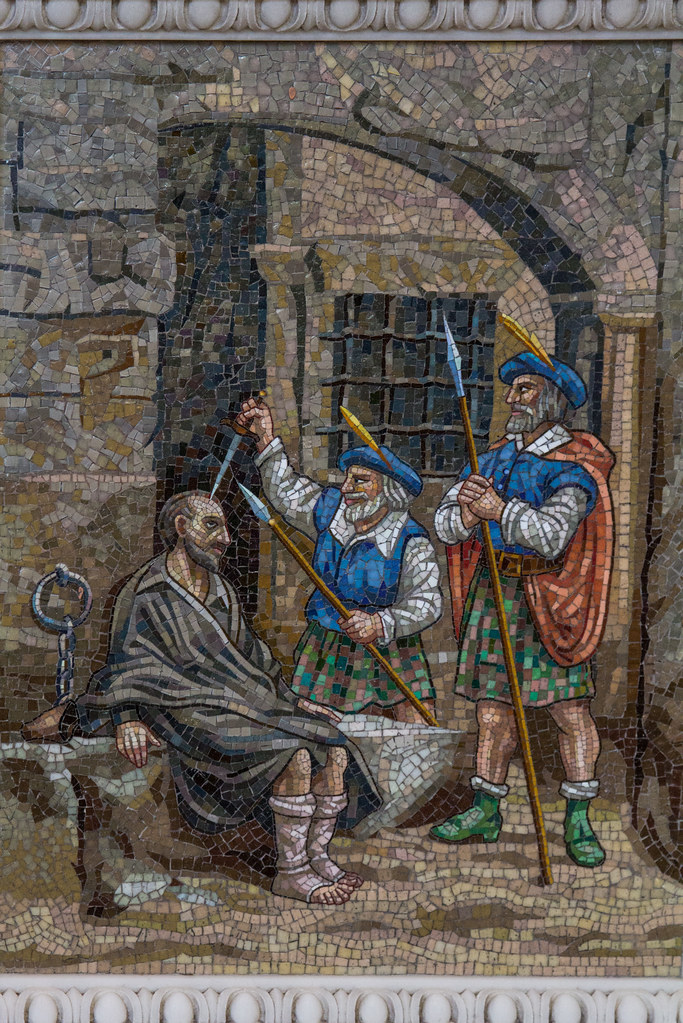Fr John Ogilvie, SJ
Born: 1579
Died: March 10, 1615
Beatified: December 22, 1929
Canonized: October 17, 1976
 Fr John Ogilvie was born in Drum-na-Keith, Banffshire in Scotland. As his father had conformed to the state-established religion, young John was raised as a Calvinist. When hewas about twelve, John left Scotland to tour and study in France, Germany, and Italy.
Fr John Ogilvie was born in Drum-na-Keith, Banffshire in Scotland. As his father had conformed to the state-established religion, young John was raised as a Calvinist. When hewas about twelve, John left Scotland to tour and study in France, Germany, and Italy.
In 1596 he decided to become a Catholic and went to Louvain and while at Scots College, he was reconciled to the Catholic Church. In June 1598, when the school closed because of lack of funds, John went to Regensburg and attended the college of the Scottish Benedictines but after six months, he transferred to the Jesuit college at Olomouc. There he was determined to be a Jesuit and at twenty, he joined the Austrian province and entered its novitiate at Brno in Moravia on Nov 5, 1599. After his first vows on Dec 26, 1601, he began his three-year course of philosophy at Graz, then taught for a while before returning to Olomouc to do his theology. In 1610 he was sent to France and was ordained in Paris at the end of that year.
Fr Ogilvie was quite eager to return to Scotland to work with his co-religionists but because it was too dangerous a place for missionaries, his superiors assigned him to Rouen, France.
 It was only in May 1613, twenty-two years since he left his native Scotland that he received word that he could return to work there. He arrived on the shores of Leith, Scotland, disguised as John Watson, a horse dealer and immediately made his way to Banffshire, the place where he spent his youth. But after a few weeks, he moved to Edinburgh to begin his ministry and soon added Renfrewshire and Glasgow to his area of activity. He had considerable success in reconciling people to the faith. He travelled frequently between Edinburgh and Glasgow, and on Oct 3, 1614, he returned to Glasgow to receive five individuals into the Church. One of these was Adam Boyd, his future betrayer. When Fr Ogilvie returned to Glasgow, Boyd informed the Protestant archbishop, John Spottiswoode, of the priest’s presence and both planned how best to apprehend him. On Oct 4, as Fr Ogilvie was waiting at the market square to be taken to where a service was to be held, the Archbishop’s men surrounded him and took him to the Archbishop who was waiting for him. When they met, the Archbishop angrily struck the priest on the face and said: “Youare bold to say Masses in a reformed city.” To which Fr Ogilvie replied: “You act like a hangman and not a bishop in striking me.” After being beaten up by the Archbishop’s men, Fr Ogilvie was imprisoned at the Bishop’s castle where he was subjected to interrogation. However, Fr Ogilvie was not to be bullied or forced into acknowledging the king’s supremacy in religious matters. After each round of interrogation, he was put into a dark, stench-filled cell, where his feet were weighted down and where he was tortured sufficiently so as to overcome his obduracy and be more willing to cooperate at the next round of examination.
It was only in May 1613, twenty-two years since he left his native Scotland that he received word that he could return to work there. He arrived on the shores of Leith, Scotland, disguised as John Watson, a horse dealer and immediately made his way to Banffshire, the place where he spent his youth. But after a few weeks, he moved to Edinburgh to begin his ministry and soon added Renfrewshire and Glasgow to his area of activity. He had considerable success in reconciling people to the faith. He travelled frequently between Edinburgh and Glasgow, and on Oct 3, 1614, he returned to Glasgow to receive five individuals into the Church. One of these was Adam Boyd, his future betrayer. When Fr Ogilvie returned to Glasgow, Boyd informed the Protestant archbishop, John Spottiswoode, of the priest’s presence and both planned how best to apprehend him. On Oct 4, as Fr Ogilvie was waiting at the market square to be taken to where a service was to be held, the Archbishop’s men surrounded him and took him to the Archbishop who was waiting for him. When they met, the Archbishop angrily struck the priest on the face and said: “Youare bold to say Masses in a reformed city.” To which Fr Ogilvie replied: “You act like a hangman and not a bishop in striking me.” After being beaten up by the Archbishop’s men, Fr Ogilvie was imprisoned at the Bishop’s castle where he was subjected to interrogation. However, Fr Ogilvie was not to be bullied or forced into acknowledging the king’s supremacy in religious matters. After each round of interrogation, he was put into a dark, stench-filled cell, where his feet were weighted down and where he was tortured sufficiently so as to overcome his obduracy and be more willing to cooperate at the next round of examination.
At the next examination before a council appointed by King James I, Fr Ogilvie again withstood its questioning and since he did not show any signs of breaking, they subjected him to torture when for eight days and nine nights he was to go without sleep. Each time he showed signs of sleepiness, the guard would jabbed him with pins or daggers and thisonly stopped the day before his next interrogation scheduled for the 22 nd Dec 1614.
Although Fr Ogilvie was physically worn out and mentally tired, he still refused to divulge the names of Catholics who had befriended him and those who had attended his services.
Unable to extract any information, he was returned to Glasgow on Dec 24 to await the king’s pleasure.
 It was during his stay at Glasgow prison for more than two months that Fr Ogilvie began writing the story of his arrest and imprisonment. And through the kindness of those who had come to visit other prisoners, he managed to have it smuggled out, sheet by sheet, and sent to his Jesuit superior. At his fourth interrogation on Jan 18, 1615, he was asked to respond to a series of questions posed by the king himself. The questions dealt with religious supremacy and were so worded that the priest would either condemn the king or renounce Catholicism. In his response, Fr Ogilvie unashamedly and unambiguously said that the Pope alone and not the king was supreme in religious matters and that the Pope had power not only to excommunicate the King but also to depose him. These answers were sent to the king in London and Fr Ogilvie knew that death was imminent. He began to prepare for heaven when he returned to his cell that day.
It was during his stay at Glasgow prison for more than two months that Fr Ogilvie began writing the story of his arrest and imprisonment. And through the kindness of those who had come to visit other prisoners, he managed to have it smuggled out, sheet by sheet, and sent to his Jesuit superior. At his fourth interrogation on Jan 18, 1615, he was asked to respond to a series of questions posed by the king himself. The questions dealt with religious supremacy and were so worded that the priest would either condemn the king or renounce Catholicism. In his response, Fr Ogilvie unashamedly and unambiguously said that the Pope alone and not the king was supreme in religious matters and that the Pope had power not only to excommunicate the King but also to depose him. These answers were sent to the king in London and Fr Ogilvie knew that death was imminent. He began to prepare for heaven when he returned to his cell that day.
Towards the end of February, James I read Fr Ogilvie’s responses and then sent orders to Glasgow that the priest’s trial was to take place on March 10 and that if he did not change his opinions he was to suffer death. On that fateful day, Fr Ogilvie faced his judgesat the Tolbooth in Glasgow’s square. The charges against him were no longer those of Archbishop Spottiswoode, that he had celebrated Mass and converted Protestants to the Catholic faith, but his denial of the king’s spiritual jurisdiction, his upholding of the Pope’s spiritual primacy, and his condemnation of the oaths of allegiance to the king and his supremacy. Two hours after his trial had begun, the jury found him guilty of high treason and he was sentenced to be hanged and quartered that afternoon.
While the judges and jury were at lunch, Fr Ogilvie remained at the Tolbooth and there he knelt and prayed. Three hours later, the sheriff came to escort him to the public square for execution. Fr Ogilvie followed with rosary in his hand, mounted the steps of the platform, kissed the scaffold and spent some time in prayer. As he was reciting the invocations from the Litany of Saints, “Lord, have mercy on me. Lord, receive my soul,” the executioner pushed him from the ladder. He did not immediately die but continued to hang in agony until the hangman grasped his legs and sharply tugged him downward, to make his death less painful.
Fr Ogilvie’s body as cut down, but contrary to the sentence, it was not quartered and was buried outside the city in a place reserved for criminals.
Fr John Ogilvie was the only canonized Scottish martyr from the time of the Reformation.
He was thirty-six when he gave his life for Christ. He was beatified by Pope Pius XI on Dec 22, 1929 and canonized by Pope Paul VI on October 17, 1976.
